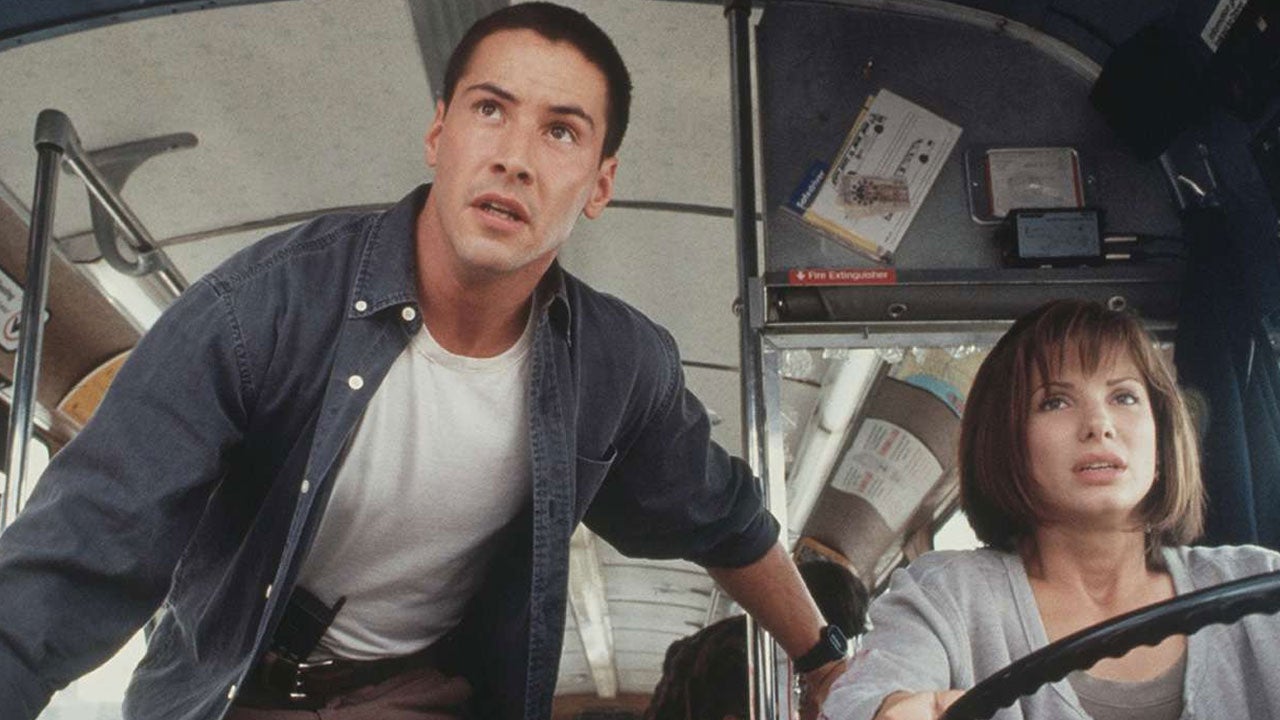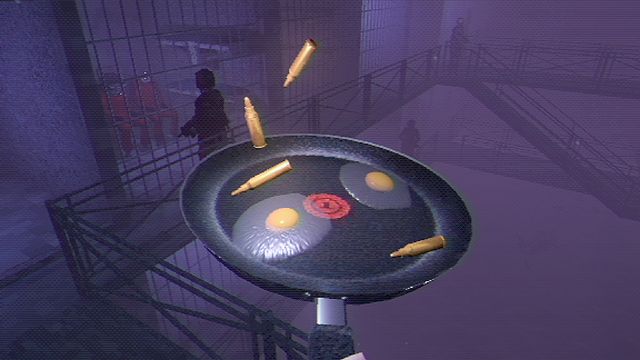When Speed first hit theaters 30 years ago, on June 10, 1994, it's doubtful the talented technicians and performers in front of and behind the camera knew how the film would reset the paradigm for what to expect from action movies in the 1990s. The premise is deceptively simple but unquestionably brilliant: There's a bomb on a bus and it’s set to go off if the bus drops below 50 miles per hour. What do you do? What do you do?
Directed by Jan de Bont and starring Keanu Reeves and Sandra Bullock, Speed marks a perfect marriage of concept, cast and execution. The proof of its success is that even though it may feel like it's been left behind by time, action flicks today owe an undisputed debt to what the movie achieved.
Speed Origins: Less ‘Minimum,’ More Die Hard on a Bus
The project that became Speed sprang from a spec script by writer Graham Yost in the early '90s, just before he took on a short-lived staff job writing for the ABC sitcom Full House and about a decade away from creating such groundbreaking TV dramas as Boomtown and Justified.
It all began with a mistaken recollection of Runaway Train, a 1985 Golan-Globus joint starring Jon Voight and Eric Roberts (featuring a story by Akira Kurosawa!) about… wait for it… a runaway train. Revisiting the film, Yost immediately realized having a bomb on there as well would have heightened the tension and made it even more intriguing story-wise.
Turn the train into a bus, add a terrorist plot (as was common during that era), and thus was born Speed. Or, as he first titled it, Minimum Speed. (He smartly ditched "Minimum" in subsequent drafts, along with upping to 50 his initial idea of the bus not going below 20 miles per hour after a friend's suggestion.)
The action landscape of the 1990s was a very different beast than it is today. Notwithstanding the occasional Batman or Darkman, superheroes were few and far between. Star Wars was a distant memory. And CGI effects, still in their infancy, were far from the ubiquitous presence they are now. Instead, action flicks relied on pyrotechnics, one-liners and the ingenuity of artists pushing the envelope of practical effects. Ah, it's a bygone era.
Yost's spec script — the entirety of which took place on the bomb-rigged bus — initially landed at Paramount (mere days after the writer had quit his Full House gig, as it happens). While a young music video director named Michael Bay tried desperately to get the job, the studio courted John McTiernan — fresh off the first Jack Ryan opus, 1990's The Hunt for Red October — to direct. At that time, McTiernan was one of Hollywood's premiere action directors, having helmed Predator in 1987 and Die Hard in 1988.
The latter's out-of-the-blue success laid in place a sturdy template of diabolical terrorists taking over an enclosed space replete with hostages and a plucky average hero tasked with saving the day. This formula led to a whole slew of summer spectacles in a similar vein: Under Siege (Die Hard on a naval vessel), Passenger 57 (Die Hard on a passenger plane), Air Force One (Die Hard on the President’s plane) and so on.
Speed fits very comfortably within that formula, which certainly helps explain why McTiernan turned it down. It was too similar to Die Hard for Die Hard’s director but not too similar for Die Hard's cinematographer, Jan de Bont, whom McTiernan recommended to Paramount and who swiftly signed on when given the offer.
At this point, despite a strong script and a promising new director onboard, Paramount passed on the project, failing to see how a film set entirely on a bus could work. Luckily for audiences, 20th Century Fox saw the potential that Paramount didn't. They picked up the project and swiftly gave it the green light once they had an assurance that more action sequences would be added.
Casting: From Bill & Ted to Keanu & Sandra
While very much indebted to the "Die Hard on a…" template, Speed benefits from, and withstands the test of time due to, the multitude of ways it leverages that formula, leaning into its tropes when necessary but just as often subverting them when practical.
Foremost among those subversions was the man cast in the lead role of LAPD SWAT member Jack Traven. While Tom Cruise, Tom Hanks, Wesley Snipes and Woody Harrelson were all offered the plum role, it went to Keanu Reeves at de Bont's recommendation. While his greatest claim to fame at the time was as lovable doofus Ted "Theodore" Logan in the Bill & Ted franchise, he'd played a cop previously in 1991's Point Break, which is what won de Bont over.
Although initially unsure if he was right for the role, Reeves saw an opportunity to do something different with the tried-and-true harried cop archetype. From the closely cropped hair (a far cry from Ted’s mop top) to his polite demeanor, Reeves' Traven is almost the anti-John McClane, carving a sturdy niche in this crowded subgenre. Indeed, it's no exaggeration to say Speed wouldn't work the way it does if not for Reeves in the lead.
Meanwhile, the role of Annie Porter, erstwhile passenger-turned-driver who serves as Reeves' love interest, went to relative newcomer Sandra Bullock after being turned down by Halle Berry (much to her regret after the fact). Bullock, who had been bouncing around the industry in minor roles for years before Speed, was promptly catapulted onto the A-list following the film's success — a position she retains to this very day.
Production: Pop Quiz, Hotshot
From the moment he signed on, de Bont immediately saw the visual possibilities in Yost's premise. However, both he and Fox wanted it further expanded for the widescreen spectacle they envisioned. To broaden its scope, de Bont added an inciting incident in the first act: an elevator in a highrise office building rigged to explode by mad bomber Howard Payne (Dennis Hopper).
With passengers trapped and panicking, Traven and his partner Harry Temple (Jeff Daniels) defuse the bomb and execute a daring rescue. The sequence remains incredibly tense and gripping even this many decades later because of how relatable the scenario is. Anyone who's ridden in an elevator has at least once pondered the possibility of it getting stuck or plummeting down the shaft. It's a communal fear that de Bont himself experienced while lensing Die Hard and finding himself and other crew stranded in an elevator in the Fox Plaza building (doubling for the film's Nakatomi Tower).
In addition to dropping us into the world of the film with a shot of adrenaline, the opening sequence introduces the buddy cop interplay between Traven and Temple and sets up the central antagonist, the demoralized ex-cop Payne. The story then segues to the second act's primary setting on the bus, after which Yost added the third act action sequence on a subway, where Traven and Payne have their final showdown.
Speaking of Payne, as initially envisioned, the character would have been merely the second banana baddie, with the big twist partway through seeing Traven's partner revealed as the chief antagonist. Hopper's casting scrapped this idea. An intimidating screen presence on his own, the Easy Rider and Apocalypse Now veteran didn't need to play runner-up to anyone, which in turn gave Daniels the chance to make a distinctive mark as Harry, the prototypical "doomed partner."
With regards to the script, it's impossible to overstate the importance of the uncredited work by Joss Whedon. The Buffy the Vampire Slayer creator (this was just after the feature film but just before the TV show) was an in-demand script doctor for his ability to punch up dialogue and character beats, and he performed an essential service for Speed. Per Yost, while the structure largely remains his, Whedon is responsible for nearly 99% of the dialogue, including the iconic "Pop quiz, hotshot," which became a runner throughout.
Another important service for the film was provided by composer Mark Mancina. A student of the Hans Zimmer style of film scores, Mancina’s thematic material melds orchestral and synth sensibilities for a sound that’s uniquely evocative of this film and the era that produced it. The central motif plays over the opening credits and establishes the movie’s identity while layering in the themes that will be utilized throughout to considerable propulsive effect.
The Legacy of Speed
"A good movie is three good scenes and no bad scenes," said legendary producer/director Howard Hawks in 1970, and Speed exemplifies the adage. From its taut opening to its gripping finale, it draws audiences in thanks to a tightly coiled plot that never forgets to put character first.
Yes, Traven is a compelling lead, as is Annie. The actors’ chemistry is immediate and palpable. Of course, it's just as important to care about the riders stuck on the bus. We want to see them survive. We're saddened when one of them doesn't. Rather than lapse into stereotypes of the country bumpkin or the overheated musclehead, they feel like real people, which makes their struggles easier to empathize with.
That said, a project like this rises or falls on the strength of its leading actor, and Reeves' casting was an absolute inspiration. It's easy to take for granted in a post-Matrix, post-John Wick world, but Reeves in the early '90s was the furthest thing from what came to mind with the phrase "action hero." This is what made him so effective in the role. Eschewing rat-a-tat witticisms, Reeves instead displays determination and frustration, but ultimately empathy. He plays Traven as a man who cares deeply about saving as many people as possible.
When Speed opened on June 10, 1994, audiences and critics agreed it was special. While there's no doubt it was part of the wave of "Die Hard on a…" movies proliferating during the decade, Speed made a mark thanks to its efficiency and originality. Coming in at just under two hours, it’s lean and tight even as it caroms from one remarkable set piece to another. Produced for a relatively meager $30 million budget, it took in more than $350 million worldwide, a remarkable return on investment.
Unfortunately, as is so often the case in Hollywood, rather than appreciate the success they achieved and leave it at that, Fox immediately developed a sequel. But while de Bont (who directed the successful Twister for Warner Bros. in the interim) was contractually obligated to return, the two stars weren't.
As such, Reeves begged off in favor of touring with his band Dogstar and starring in The Devil's Advocate. Meanwhile, Bullock was lured back to headline the sequel with the promise of her passion project, the romantic drama Hope Floats, getting greenlit. (It was and did pretty well upon its 1998 release.)
Jason Patric stepped in for Reeves, with Willem Defoe as the new baddie. The result was 1997's execrable Speed 2: Cruise Control, a remarkable debacle most notable for making as many missteps as the original Speed didn't. With no involvement from Graham Yost, the sequel swapped the elevator-bus-subway trifecta for an out-of-control cruise ship, losing most of the thrills in the process. Costing an eye-popping $160 million, it barely crested that total worldwide. Thus ended any franchise dreams for Fox and Speed.
It's worth noting that Speed 2 is barely a blip when considering the original's cumulative impact. While it's been a long time since it commanded the zeitgeist (and de Bont sadly never quite matched what he achieved here), there's no denying how effectively the movie embodied its particular moment while also transcending it.
The practical effects remain a marvel of engineering and execution, but what truly makes the film stand apart even today is how far you can get when foregrounding relatable characters and an engrossing story, even in an action blockbuster. Especially in an action blockbuster.
It may have taken an unlikely journey to the screen, but from concept to casting to completion, Speed is about as close to a perfect movie as possible. Three decades after first thrilling audiences during its theatrical run, it still guarantees an adrenaline rush.









